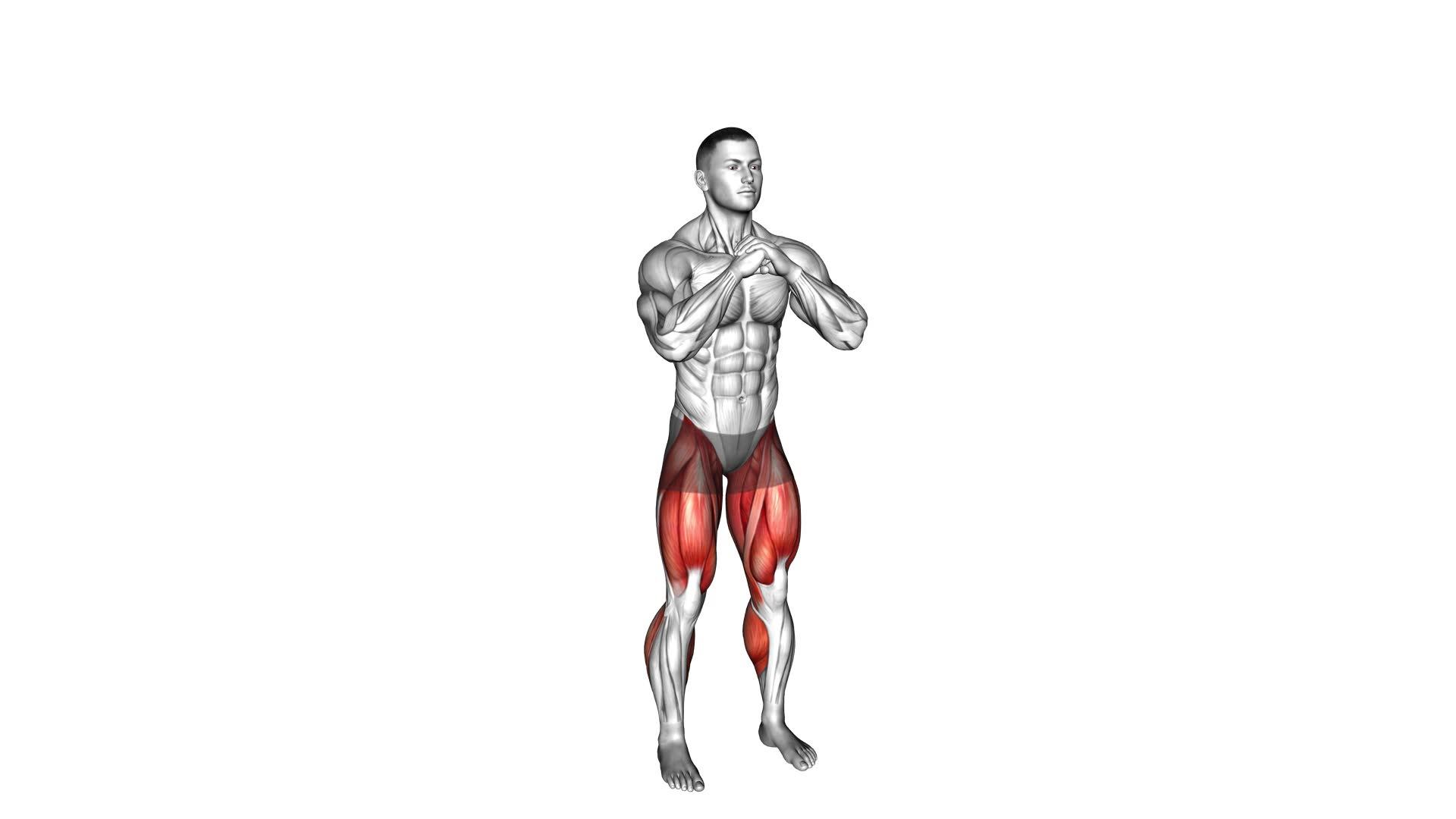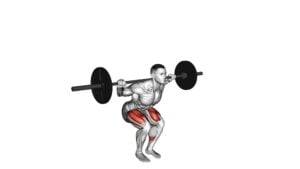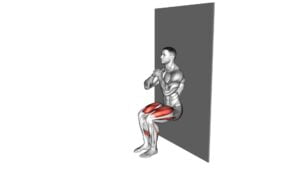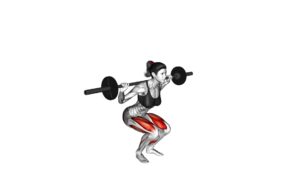Wide Stance Jump Squat to Narrow Stance Jump Squat – Video Exercise Guide & Tips

Are you looking for a challenging lower body exercise that targets multiple muscle groups?
Watch This Exercise Video
Look no further than the wide stance jump squat to narrow stance jump squat.
This dynamic movement combines explosive power with lower body strength for a total body workout.
In this video exercise guide, you'll learn the proper form and technique, progression tips for beginners, and advanced variations to push your limits.
Avoid common mistakes and get ready to take your fitness to the next level.
Key Takeaways
- Wide stance jump squats engage multiple muscle groups, increase lower body strength and power, and activate glutes and inner thigh muscles.
- Proper form and technique include starting with feet wider than shoulder-width apart, keeping back straight and knees in line with toes, and exploding off the ground with an engaged core and glutes.
- Progression tips for beginners include mastering basic wide stance jump squats, gradually widening the stance, performing bodyweight squats without jumping, and incorporating weights or resistance bands for increased difficulty.
- Advanced variations to challenge yourself include pistol squats, depth jumps, split squat jumps, and Bulgarian split squats.
Benefits of Wide Stance Jump Squat
You can experience increased lower body strength and power by incorporating wide stance jump squats into your workout routine. This exercise engages multiple muscle groups, including your quadriceps, hamstrings, glutes, and calves, resulting in improved muscular engagement. The wide stance jump squat requires you to position your feet wider than shoulder-width apart, which increases the activation of your glutes and inner thigh muscles.
By performing wide stance jump squats, you can enhance your power and explosiveness. The explosive movement involved in this exercise helps to develop fast-twitch muscle fibers, which are responsible for generating quick and powerful movements. This can be particularly beneficial for athletes participating in sports that require sudden bursts of speed or strength, such as basketball or sprinting.
Furthermore, wide stance jump squats can also improve your vertical jump. The explosive nature of this exercise helps to strengthen the muscles involved in jumping, allowing you to generate more force and propel yourself higher off the ground.
Incorporating wide stance jump squats into your workout routine can be an effective way to increase lower body strength, power, and explosiveness. Remember to start with proper form and gradually increase the intensity to avoid injury. Always consult with a fitness professional before starting any new exercise program.
Proper Form and Technique
To ensure proper form and technique during wide stance jump squats, it's important to consistently practice and refine your movement patterns. Proper technique involves starting with your feet wider than shoulder-width apart, toes pointed slightly outward. As you lower into the squat, make sure to keep your back straight, chest up, and knees tracking in line with your toes. Engage your core and glutes as you explode off the ground, extending your hips and knees to jump as high as possible. Land softly on the balls of your feet and immediately go into the next rep.
Common mistakes to avoid include allowing your knees to collapse inward, rounding your back, or not fully extending your hips and knees during the jump. It's also important to avoid leaning too far forward or backward, as this can put unnecessary strain on your lower back.
By practicing proper technique and consistently refining your movement patterns, you won't only maximize the benefits of wide stance jump squats but also reduce the risk of injury.
Now, let's move on to some progression tips for beginners to gradually increase the difficulty of this exercise and continue challenging your muscles.
Progression Tips for Beginners
Looking to gradually increase the difficulty of your wide stance jump squats? As a beginner, it's important to start with proper form and technique before progressing to more challenging variations. Here are some progression tips to help you build leg strength and improve your jump squat technique.
First, focus on mastering the basic wide stance jump squat. Begin with your feet shoulder-width apart and toes pointed slightly outward. Engage your core and lower down into a squat position, keeping your knees in line with your toes. Explode upward, pushing through your heels and extending your hips and knees. Land softly and repeat for the desired number of repetitions.
To modify this exercise for beginners, you can start with a narrower stance. This will help you maintain balance and stability as you build strength in your legs. Gradually widen your stance as you become more comfortable and confident.
Another modification for beginners is to perform the jump squat without actually jumping. This is known as a bodyweight squat. Instead of jumping, focus on the explosive upward movement and controlled descent. This will still engage your leg muscles and help you build strength.
Remember, proper form is key to prevent injury and maximize results. Keep your chest up, back straight, and knees in line with your toes throughout the movement. As you progress, you can incorporate weights or resistance bands to increase the difficulty and continue challenging your leg muscles.
Advanced Variations to Challenge Yourself
To challenge yourself further, try incorporating advanced variations into your jump squat routine. These plyometric exercises won't only push your limits but also help you build explosive power and strength.
Here are four advanced squat variations to take your workout to the next level:
- Pistol Squats: This exercise requires incredible balance and strength. Stand on one leg and extend the other leg out in front of you. Lower yourself into a deep squat position while keeping your extended leg off the ground. Then, push through your heel to return to the starting position.
- Depth Jumps: Start by standing on top of a box or platform. Step off and immediately upon landing, explode back up into a jump squat. This exercise emphasizes the stretch-shortening cycle and helps improve your reactive power.
- Split Squat Jumps: Begin in a lunge position, with one foot forward and the other foot back. Lower into a lunge and then explosively jump up, switching your leg positions mid-air. Land softly and repeat on the other side.
- Bulgarian Split Squats: Elevate your back foot on a bench or step. Lower yourself into a squat position, keeping your front knee in line with your toes. Push through your front heel to return to the starting position. This exercise targets your glutes, quads, and hamstrings.
Incorporating these advanced squat variations into your routine will challenge your muscles in new ways and help you take your fitness to the next level. Remember to always prioritize proper form and listen to your body to prevent injuries.
Common Mistakes to Avoid
Avoid these common mistakes to maximize the effectiveness of your wide stance jump squat to narrow stance jump squat exercise.
Proper technique is essential to ensure that you're targeting the right muscles and reducing the risk of injury. Here are some common mistakes to watch out for:
- Lack of proper warm-up: Skipping the warm-up can lead to muscle strain and decreased performance. Make sure to warm up your muscles with dynamic stretches and light cardio before attempting the wide stance jump squat to narrow stance jump squat exercise.
- Incorrect foot positioning: Your feet should be shoulder-width apart for the wide stance jump squat and hip-width apart for the narrow stance jump squat. Avoid positioning your feet too close together or too far apart, as this can compromise your stability and balance.
- Insufficient depth: To fully engage your leg muscles, aim to squat down until your thighs are parallel to the ground. Going too shallow can limit the benefits of the exercise, while going too deep can strain your knees and lower back.
- Lack of control: It's important to maintain control throughout the entire movement. Avoid bouncing at the bottom of the squat and instead focus on a smooth and controlled motion.
- Neglecting proper form: Keep your back straight, chest up, and knees in line with your toes throughout the exercise. Avoid rounding your back or letting your knees collapse inward.
Frequently Asked Questions
How Many Wide Stance Jump Squats Should I Do in a Workout?
For an effective workout, start with a comfortable number of wide stance jump squats. As a beginner, it's important to modify the exercise to suit your fitness level. Gradually increase the number of reps as you become more comfortable and stronger.
Wide stance jump squats offer great benefits for your lower body workout routine. They target your glutes, quads, and hamstrings, helping to build strength and power.
Remember to listen to your body and adjust the number of reps accordingly.
Can Wide Stance Jump Squats Help Improve My Vertical Jump?
Wide stance jump squats can indeed help improve your vertical jump. By working on explosive power and lower body strength, this exercise targets the muscles needed for a higher jump.
To maximize the benefits, ensure proper form by starting with a wide stance, bending your knees and hips to lower into a squat, and then exploding upward while bringing your feet together.
Incorporating wide stance jump squats into your workout routine can lead to significant improvements in your vertical jump.
Are Wide Stance Jump Squats Suitable for People With Knee Injuries?
Wide stance jump squats can be challenging for people with knee injuries. However, there are modifications you can make to make them more suitable. By transitioning to narrow stance jump squats, you can reduce the strain on your knees while still benefiting from the exercise.
It's important to listen to your body and consult with a professional if you have any concerns. Remember, proper form and technique are crucial to prevent further injury.
Can Wide Stance Jump Squats Be Incorporated Into a HIIT (High-Intensity Interval Training) Routine?
Wide stance jump squats can definitely be incorporated into a HIIT routine. They offer numerous benefits for overall fitness, including improving lower body strength, power, and explosiveness.
However, it's important to note that beginners may need to modify the exercise to ensure proper form and prevent injury. Starting with a narrower stance or reducing the depth of the squat can be effective modifications.
Always listen to your body and consult with a fitness professional if needed.
What Muscles Are Primarily Targeted During Wide Stance Jump Squats?
During wide stance jump squats, you primarily target your quadriceps, glutes, and hamstrings. These muscles work together to propel you upward and generate power.
Wide stance jump squats also engage your core muscles to maintain stability and balance.
The benefits of this exercise include improved lower body strength, increased explosive power, and enhanced athletic performance.
Incorporating wide stance jump squats into your workout routine can help you achieve your fitness goals and enhance overall muscle development.
Conclusion
To conclude, the wide stance jump squat to narrow stance jump squat is a highly effective exercise that targets multiple muscle groups, improves lower body strength, and enhances explosive power.
By following proper form and technique, beginners can gradually progress and challenge themselves with advanced variations.
It's important to avoid common mistakes to ensure safety and maximize results.
Incorporating this exercise into your fitness routine can yield great benefits for overall strength and athletic performance.

Author
Years ago, the spark of my life’s passion ignited in my mind the moment I stepped into the local gym for the first time. The inaugural bead of perspiration, the initial endeavor, the very first surge of endorphins, and a sense of pride that washed over me post-workout marked the beginning of my deep-seated interest in strength sports, fitness, and sports nutrition. This very curiosity blossomed rapidly into a profound fascination, propelling me to earn a Master’s degree in Physical Education from the Academy of Physical Education in Krakow, followed by a Sports Manager diploma from the Jagiellonian University. My journey of growth led me to gain more specialized qualifications, such as being a certified personal trainer with a focus on sports dietetics, a lifeguard, and an instructor for wellness and corrective gymnastics. Theoretical knowledge paired seamlessly with practical experience, reinforcing my belief that the transformation of individuals under my guidance was also a reflection of my personal growth. This belief holds true even today. Each day, I strive to push the boundaries and explore new realms. These realms gently elevate me to greater heights. The unique combination of passion for my field and the continuous quest for growth fuels my drive to break new ground.







